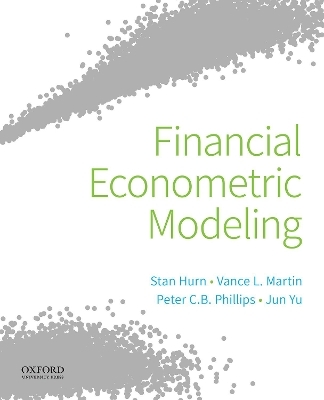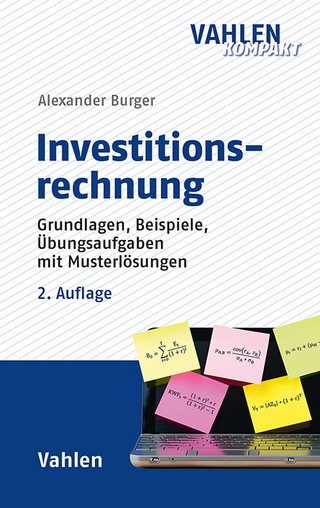
Financial Econometric Modeling
Oxford University Press Inc (Verlag)
978-0-19-085706-6 (ISBN)
Financial Econometric Modeling delivers a self-contained first course in financial econometrics, providing foundational ideas from financial theory and relevant econometric technique. From this foundation, the book covers a vast arena of modern financial econometrics that opens up empirical applications with data of the many different types that are now generated in financial markets. Every chapter follows the same principle ensuring that all results reported in the book may be reproduced using standard econometric software packages such as Stata or EViews, with a full set of data and programs provided to ensure easy implementation.
Stan Hurn is Professor of Econometrics at Queensland University of Technology. He held previous positions at the University of Glasgow and Brasenose College, Oxford. He is a Fellow of the Society of Financial Econometrics and Founding Member and Director of the National Centre for Econometric Research in Australia. Vance L. Martin is Professor of Econometrics at the University of Melbourne. He has published widely in the area of financial econometrics and is coauthor, with Stan Hurn, of the highly successful introductory text Econometric Modeling with Time Series Specification, Estimation, and Testing (2013). Peter C.B. Phillips is Sterling Professor of Economics at Yale University, Distinguished Professor at the University of Auckland, and Distinguished Term Professor at Singapore Management University. He is Founding Editor of the journal Econometric Theory and an elected fellow of many learned societies including the British Academy, the American Academy of Arts and Sciences, and the Royal Society of New Zealand. His work has advanced diverse areas of econometrics, introduced new methods of research in financial economics, and influenced applied work throughout the social and business sciences. Jun Yu is Lee Kong Chian Professor of Economics and Finance at Singapore Management University and Lead Principal Investigator at the Centre for Research on the Economics of Aging (CREA). He is a Fellow of the Journal of Econometrics and the Society of Financial Econometrics, and an Associate Editor of the Journal of Econometrics, Econometric Theory, and Journal of Financial Econometrics.
I: Fundamentals1. Prices and Returns1.1 What is Financial Econometrics?1.2 Financial Assets1.3 Equity Prices and Returns1.4 Stock Market Indices1.5 Bond Yields1.6 Exercises2. Financial Data2.1irst Look at the Data2.2 Summary Statistics2.3 Percentiles and Value at Risk2.4 The Efficient Market Hypothesis2.5 Exercises3. Linear Regression3.1 The Capital Asset Pricing Model3.2 Multi-factor CAPM3.3 Properties of Ordinary Least Squares3.4 Diagnostics3.5 Measuring Portfolio Performance3.6 Minimum Variance Portfolios3.7 Event Analysis3.8 Exercises4. Stationary Dynamics4.1 Stationarity4.2 Univariate Time Series Models4.3 Autocorrelation and Partial Autocorrelations4.4 Mean Aversion and Reversion in Returns4.5 Vector Autoregressive Models4.6 Analysing VARs4.7 Diebold-Yilmaz Spillover Index4.8 Exercises5. Nonstationarity5.1 The RandomWalk with Drift5.2 Characteristics of Financial Data5.3 Dickey-Fuller Methods and Unit Root Testing5.4 Beyond the Simple Unit Root Framework5.5 Asset Price Bubbles5.6 Exercises6. Cointegration6.1 The Present Value Model and Cointegration6.2 Vector Error Correction Models6.3 Estimation6.4 Cointegration Testing6.5 Parameter Testing6.6 Cointegration and the Gordon Model6.7 Cointegration and the Yield Curve6.8 Exercises7. Forecasting7.1 Types of Forecasts7.2 Forecasting Univariate Time Series Models7.3 Forecasting Multivariate Time Series Models7.4 Combining Forecasts.7.5 Forecast Evaluation Statistics7.6 Evaluating the Density of Forecast Errors7.7 Regression Model Forecasts7.8 Predicting the Equity Premium7.9 Stochastic Simulation of Value at Risk7.10 ExercisesII. Methods8. Instrumental Variables8.1 The Exogeneity Assumption8.2 Estimating the Risk-Return Tradeoff8.3 The General Instrumental Variables Estimator8.4 Testing for Endogeneity8.5 Weak Instruments8.6 Consumption CAPM8.7 Endogeneity and Corporate Finance8.8 Exercises9. Generalised Method of Moments9.1 Single Parameter Models9.2 Multiple Parameter Models9.3 Over-Identified Models9.4 Estimation9.5 Properties of the GMM Estimator9.6 Testing9.7 Consumption CAPM Revisited9.8 The CKLS Model of Interest Rates9.9 Exercises10. Maximum Likelihood10.1 Distributions in Finance10.2 Estimation by Maximum Likelihood10.3 Applications10.4 Numerical Methods10.5 Properties10.6 Quasi Maximum Likelihood Estimation10.7 Testing10.8 Exercises11. Panel Data Models11.1 Types of Panel Data11.2 Reasons for Using Panel Data11.3 Two Introductory Panel Models11.4 Fixed and Random Effects Panel Models11.5 Dynamic Panel Models11.6 Nonstationary Panel Models11.7 Exercises12. Latent Factor Models12.1 Motivation12.2 Principal Components12.3atent Factor CAPM12.4 Dynamic Factor Models: the Kalman Filter12.5arametric Approach to Factors12.6 Stochastic Volatility12.7 ExercisesIII: Topics13. Univariate GARCH Models13.1 Volatility Clustering.13.2 The GARCH Model13.3 Asymmetric Volatility Effects13.4 Forecasting13.5 The Risk-Return Tradeoff.13.6 Heatwaves and Meteor Showers13.7 Exercises14. Multivariate GARCH Models14.1 Motivation14.2 Early Covariance Estimators14.3 The BEKK Model14.4 The DCC Model14.5 Optimal Hedge Ratios14.6 Capital Ratios and Financial Crises14.7 Exercises15. Realised Variance and Covariance15.1 High Frequency Data15.2 Realised Variance15.3 Integrated Variance15.4 Microstructure Noise15.5 Bipower Variation and Jumps15.6 Forecasting15.7 The Realised GARCH Model15.8 Realised Covariance15.9 Exercises16. Microstructure Models16.1 Characteristics of High Frequency Data16.2 Limit Order Book16.3 Bid Ask Bounce16.4 Information Content of Trades16.5 Modelling Price Movements in Trades16.6 Modelling Durations16.7 Modelling Volatility in Transactions Time16.8 Exercises17. Options17.1 Option Pricing Basics.17.2 The Black-Scholes Option Price Model17.3irst Look at Options Data17.4 Estimating the Black-Scholes Model17.5 Testing the Black-Scholes Model17.6 Option Pricing and GARCH Volatility17.7 The Melick-Thomas Option Price Model17.8 Nonlinear Option Pricing.17.9 Using Options to Estimate GARCH Models17.10 Exercises18. Extreme Values and Copulas18.1 Motivation.18.2 Evidence of Heavy Tails18.3 Extreme Value Theory18.4 Modelling Dependence using Copulas18.5 Properties of Copulas18.6 Estimating Copula Models18.7 MGARCH Model Using Copulas18.8 Exercises19. Concluding RemarksA. Mathematical PreliminariesA.1 Summation NotationA.2 Expectations OperatorA.3 DifferentiationA.4 Taylor Series ExpansionsA.5 Matrix AlgebraA.6 Transposition ofatrixA.7 Symmetric MatrixB. Properties of EstimatorsB.1 Finite Sample PropertiesB.2 Asymptotic PropertiesC. Linear Regression Model in Matrix NotationD. Numerical OptimisationE. Simulating CopulasAuthor indexSubject index
| Erscheinungsdatum | 30.06.2020 |
|---|---|
| Verlagsort | New York |
| Sprache | englisch |
| Maße | 231 x 191 mm |
| Gewicht | 1089 g |
| Themenwelt | Wirtschaft ► Betriebswirtschaft / Management ► Finanzierung |
| Wirtschaft ► Volkswirtschaftslehre ► Ökonometrie | |
| ISBN-10 | 0-19-085706-4 / 0190857064 |
| ISBN-13 | 978-0-19-085706-6 / 9780190857066 |
| Zustand | Neuware |
| Haben Sie eine Frage zum Produkt? |
aus dem Bereich


